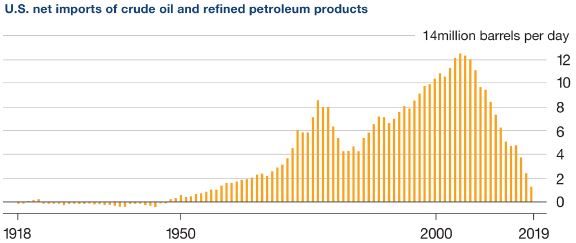
The Energy Edge: U.S. Becomes Net Oil Exporter
Today’s Takeaway: U.S. Becomes Net Oil Exporter for the First Time Since the 1940s
Right before the calendar turned to December, the United States achieved something it hasn’t done since around World War II. According to the U.S. Energy Information Administration, during the week that ended November 30, the country became a net exporter of oil and refined fuels for the first time in nearly 75 years.
Not since the mid-1940s have domestic exports exceeded imports of one of the world’s most desirable commodities. At the end of November, the U.S. exported 3.2 million barrels of oil along with about 5.8 million barrels of gasoline, diesel, jet fuel and other products. During that same time, imports of those same fuels totaled 8.8 million barrels a day in the week, making the country a net exporter.
Shale Boom Dramatically Reduces U.S. Dependence on Foreign Oil

Source: Bloomberg
What’s the point?
Led by the Shale booms in the Marcellus region of Pennsylvania, Permian region of Texas and New Mexico, and the Bakken in North Dakota, it looks like America has finally been able to achieve what some have dubbed “energy independence.” Though this full shift to net exporter could be somewhat short lived, it is expected that sometime next year or in 2020, the U.S. will retain the title of oil exporter for an extended period of time. Beyond that, it also doesn’t hurt that by 2040, domestic production of natural gas is expected to more than double.
As natural gas companies are well aware, increased investment in the industry has enabled companies to more easily transport fuel throughout the country and across the globe. In 2016, the Appalachia region alone was the 3rd largest natural gas producer in the world, topping Iran, Saudi Arabia, Qatar and others. And construction of pipelines in the Permian and Marcellus regions, as well as the construction of multiple new terminals along the Gulf of Mexico, have only served to further increase U.S. exports.
Why should I care?
For decades, especially when the U.S. was importing more than 12 million barrels of crude oil and refined petroleum products per day in the early 2000s, many felt this time would never come. The U.S. was in too deep, they said, and any idea that the country could return to its mid-20th century days as a net exporter were far-fetched.
But thanks to a number of entrepreneurial companies and truly revolutionary innovation, the U.S. is now the global leader in petroleum production, ahead of the oil behemoths of Russia and Saudi Arabia. Of course, that wouldn’t be possible without favorable policies, both at the federal and especially the state level, that allowed for responsible development. Almost three years ago to the day, Alaska Senator Lisa Murkowski pushed Congress to agree to lift a 40-year ban on oil exports as part of its budget deal made in December of 2015.
“At the time, the ban didn’t influence much change since conditions weren’t exactly ripe for exports back in 2015, but the provision - among others - helped bolster U.S. oil production plenty in the years that followed and get us to where we are today,” said Ed Hild, current principal in Buchanan’s government relations practice and Chief of Staff for Senator Murkowski during the time the ban was lifted.
Now, after Pennsylvania set another natural gas production record in Q3 2018, producing 18.5 percent more volume compared to the same period in 2017, the conversation naturally flows to the immense potential that still remains for putting this supply to good use at home.
With energy independence theoretically achieved (at least for the time being), companies and legislators at the state and federal level need to work together to find ways to enable more domestic downstream development. Though we’ve made significant progress during the past few decades, the end-use possibilities of this plentiful fuel source should be too enticing for investors, the industry and the folks in Washington to overlook.
For more cutting-edge perspectives on the most compelling news, facts and figures impacting the U.S. energy industry, read other editions of The Energy Edge.


